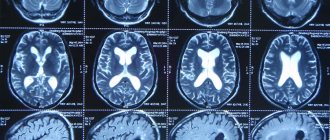Why does the right side of my head hurt?
Physiological reasons
Episodic hemicranias are detected in many healthy people and disappear after taking an anesthetic, sleep, and rest. There is a connection with external circumstances and no tendency to relapse. Provoking factors are considered to be acute and prolonged stress, mental and physical overload. The right side of the head can also hurt due to alcohol intoxication, frequent smoking, or abuse of caffeine-containing drinks.
Migraine
A distinctive feature of migraine is paroxysmal unilateral pain with periodic change of half of the head. For unknown reasons, the disease most often manifests itself as pain in the right side of the head. Painful sensations are localized in the area of the eye, forehead, temple, and less often in the occipital region. They often start in one place and then cover the entire half of the head.
For most types of migraine, symptoms persist for a period of several hours to 3 days. Some signs depend on the type of disease:
- Simple migraine.
The most common. Accompanied by classic attacks without an aura, sometimes preceded by a prodrome in the form of impaired performance, deterioration of the emotional state. Nausea, vomiting, light and sound phobia are noted. - Migraine with aura.
Paroxysms are the same as in the previous case. They are preceded by an aura, which is most often represented by visual disturbances. There may be unusual sounds and smells, sensory disturbances, and difficulty speaking. - Vestibular migraine.
A typical feature is dizziness, which occurs at the prodrome stage and may persist or disappear with the onset of the headache. Sometimes different variants of the aura are observed. - Ocular migraine.
Along with visual disturbances (flickering, the appearance of scotomas, loss of parts of the visual field) that precede cephalalgia and persist for 10-20 minutes, this type of migraine differs from others in its atypical duration - less than 3 hours. - Ophthalmoplegic migraine.
Another variant of the disease with ophthalmological disorders and unusual duration. Symptoms persist for more than a week. Disturbances from the oculomotor, and less commonly, trochlear or abducens nerves occur on days 1-4. Diplopia, mydriasis, strabismus, and drooping eyelids are possible.
If the duration of a migraine attack (except for types with ocular symptoms) is more than 3 days or paroxysms during this time continuously occur one after another, migraine status is diagnosed. This condition is characterized by high pain intensity, wave-like decrease and increase in symptoms, and progressive dehydration caused by repeated vomiting.
Paroxysmal hemicrania
It occurs with episodes of extremely intense pain in the right or left half of the head with the epicenter in the orbit, temporal zone, crown, back of the head, and forehead. It can be provoked by sudden turns of the head, drinking alcohol, or strong emotions. Pain sensations are stabbing, boring, burning, pulsating, aching. The duration of the episode is 5-45 minutes; in severe cases, up to 40 attacks occur during the day. Paroxysmal hemicrania is accompanied by autonomic disorders: lacrimation, local hyperhidrosis, feeling of heat, nasal congestion.
Pain in the right side of the head
Hypnic headache
This primary cephalgia is characterized by its occurrence only during sleep. Separately, the right or left half of the head is affected in 40% of patients; in other cases, the pain is bilateral. At the beginning of the attack, the patient awakens, after the end of the paroxysm he falls asleep again. Hypnic headache is dull, moderate, rarely severe. Diagnosed in people of the older age group, once it appears, it continues to bother throughout life.
Cluster headache
Unlike migraines, the left side of the head is affected more often than the right, but right-sided cephalgia is also possible. The majority of patients are young men. Attacks of cluster headaches develop suddenly, increase within 1-3 minutes, and stop after 15-120 minutes. The painful sensations are extremely intense. Localized mainly in the orbital area, stabbing, burning, tearing, pressing. They decrease with moderate physical activity, so during paroxysm patients constantly move.
Vertebrobasilar insufficiency
Pain in half of the head is typical for the spondylogenic form of the disease. The left and right halves are affected equally often, the localization is determined by the side on which blood flow disturbances occur in the vertebral artery. The pain is provoked by movements of the neck, its severity clearly depends on the position of the head. Painful sensations with vertebrobasilar insufficiency appear in the back of the head, cover the temple, forehead, orbit, and radiate to the upper limb. Accompanied by autonomic and cerebellar disorders, visual and hearing disorders.
Other cerebral pathologies
Pain in the right side of the head is observed with brain tumors, limited arachnoiditis of the corresponding localization. With neoplasms, it appears in the early stages of the disease, strong or moderate, bursting, deep, often observed in the form of attacks. With arachnoiditis, it occurs chronically, gradually progresses, worries mainly in the morning, and is supplemented by neurosis-like symptoms.
Other reasons
Right-sided cephalgia can be detected in the following diseases:
- Sinusitis.
The pain syndrome is bursting, pulsating, provoked by sinusitis or sinusitis of the right paranasal sinuses. It is more pronounced in the forehead area, extending to the temple. Nasal discharge and general signs of an inflammatory process are characteristic. - Mastoiditis.
Manifests simultaneously with acute purulent otitis media or a few days after its onset. There is intense pain behind the ear, spreading to adjacent parts of the head, increased temperature, and drainage of pus from the ear. - Temporal arteritis.
Rheumatic pathology is caused by damage to the temporal artery and is accompanied by throbbing, dull pain in the temple. The pain intensifies at night and gradually progresses. Combined with general intoxication manifestations. - Spinal diseases.
Pain in the right side of the head is caused by right-sided compression of nerves and blood vessels. It is detected in patients with osteochondrosis and intervertebral hernia. Neck pain is typical and gets worse with movement. Possible muscle weakness, numbness of the right hand.
Headaches in the temple area
Headache in the temples is one of the types of cephalalgia, which occurs equally often in both men and women. It can be unilateral or bilateral, pulsating or pressing, last several minutes or drag on for several hours or even days. A headache that persists for a long time requires consultation with a neurologist, since there are many reasons for this condition.
In our Private Practice clinic, you can be examined by leading neurologist Larisa Aleksandrovna Baldorzhieva and receive an individual treatment plan at an affordable cost. You can make an appointment any day of the week using the phone numbers provided.
Causes and symptoms
Any pain requires careful differential diagnosis. Pain syndrome can be a consequence of neurosis or signal any somatic pathology. Below we will look at the most common causes of headaches in the temple area.
Change in blood pressure
Low blood pressure manifests itself in the form of a throbbing or pressing headache in the temples. In addition, weakness, nausea, flickering of spots before the eyes and coldness of the extremities are possible. With increased pressure, the pain is localized not only in the temples, but also in the back of the head. At the peak of high blood pressure, a person may experience nausea or even vomiting, the face begins to turn red, and photopsia (multiple flashes) appear before the eyes.
Stress
Against the background of chronic stress, all vital processes in the body are disrupted, including a deterioration in the tone of the vascular wall, an increase or decrease in blood pressure, causing prolonged pressing pain in the temples.
Migraine
Unilateral throbbing pain in the temple should alert the doctor to the possibility of migraine. Migraine is a hereditary disease that manifests itself in the form of instability of blood vessels in the brain. Such people often develop headaches due to climate change, severe stress and other external irritants. The disease itself does not cause serious harm to health, but it does cause a lot of inconvenience to a person. An attack can last from several seconds to several days, in some cases an “aura” occurs - a symptom complex that appears immediately before the onset of a migraine (spots before the eyes, nausea, photophobia, weakness, etc.).
Infection
If you have a headache in your temples, and the day before you sat for a long time in front of the air conditioner, it’s a cold. In addition to pain, other manifestations of infection may cause concern: runny nose, cough, hoarseness, weakness, fever.
Intoxication
Alcohol abuse and cigarette smoking have a negative effect on the walls of blood vessels, which leads to the development of pain.
Diseases of the musculoskeletal system
Osteochondrosis, neuralgia and other pathological conditions can cause shooting headaches affecting the back of the head, crown and/or temple.
Endocrine disorders
During puberty, pregnancy, lactation and menopause, hormonal imbalances may occur, leading to regularly occurring headaches. Also, due to diseases of hormone-producing organs (thyroid gland, pancreas), pain syndrome can begin spontaneously and go away with treatment of the underlying disease.
Dental pathology
This is one of the reasons that doctors often miss, attributing the occurrence of pain in the temples to nervous tension. If you haven’t been to the dentist for a long time, and you couldn’t determine the cause of your headache, contact your nearest dental clinic!
Diagnostics
Diagnostic measures at the Private Practice clinic include laboratory (blood and urine tests) and instrumental research methods (x-ray of the spine and skull, ultrasound of cerebral vessels, etc.). We have our own laboratory and modern diagnostic equipment.
Treatment
Headache is a symptom that has been successfully treated by a neurologist at our clinic for many years. The prescription of drugs depends on the cause of the pain syndrome. Dr. Baldorzhieva can prescribe nootropics, antidepressants, anticonvulsants, muscle relaxants, painkillers, depending on the situation. Osteopathic treatment of headaches provides excellent results, which is safe and effective. If necessary, the patient is referred for consultation with related specialists.
If you suffer from headaches in the temple area, do not self-medicate, contact the experienced doctors of our clinic and receive qualified medical care.
You can make an appointment with a doctor by calling
+7+7 (495) 980-13-16
Diagnostics
Determining the pathology that causes pain in the right side of the head is the responsibility of a neurologist. If necessary, the patient is referred for consultation to an otolaryngologist, rheumatologist, or oncologist. To identify focal symptoms, a neurological examination is performed. Diagnosis of primary cephalgia is based on compliance of the clinical picture of the disease with certain criteria. Additional techniques are used during differential diagnosis. For other pathologies, the list of procedures is determined taking into account the nature of the disease. May be assigned:
- Ultrasonography.
Duplex and Doppler sonography are informative in assessing the condition of blood vessels. In case of vertebrobasilar insufficiency, they are performed to study the cervical and intracranial vessels, determine the localization and extent of stenosis. In other cases, they are prescribed to exclude vascular diseases. - Tomography.
Patients with arachnoiditis and tumors are referred for MRI of the brain. If the vertebral artery is damaged, MR angiography is performed. Spinal diseases are diagnosed using CT or MRI of the cervical spine. - Otolaryngological examination.
Necessary for sinusitis, mastoiditis. Along with an external examination, anterior rhinoscopy, otoscopy, and diagnostic puncture of the accessory sinus can be performed. - Radiography.
Images of the cervical spine are recommended for disc herniation, osteochondrosis, and suspected compression of the vertebral artery by surrounding hard structures. X-rays of the temporal bone are indicated for mastoiditis, and of the paranasal sinuses for sinusitis.
Electroencephalography
Prevention of pain in the temporal region
To prevent headaches from bothering you and interfering with your usual lifestyle, you should follow some simple rules, the main ones of which are:
- When working at a computer or driving for a long time, take short breaks and give your eyes a rest.
- Sleep at least 6 hours a day.
- Include foods containing vitamin C (such as orange or cherry juice) in your daily diet.
- Regularly ventilate the room you are in during the day.
- Every day, set aside half an hour for walking.
You need to understand that pain in the temporal region is the first “bell” that certain changes are occurring in the body (in particular in the brain). If headache attacks are regular, you should definitely consult a doctor.
Treatment
Conservative therapy
The treatment plan is drawn up taking into account the nature of the disease. The following medications and non-drug methods are used:
- Migraine.
To eliminate paroxysms, non-narcotic analgesics are prescribed. For persistent attacks, blockades are performed. For intense excruciating pain and migraine status, triptans are used in tablets, rectal suppositories, and solutions for parenteral administration. The last two options allow you to solve the problem of taking the drug for persistent vomiting. - Paroxysmal hemicrania.
NSAIDs, glucocorticosteroids, and calcium channel blockers are effective. Depending on the severity of the pathology, medications are taken in short courses or continuously. - Cluster headache.
Painful attacks are eliminated with the help of triptans and applications of local anesthetics to the nasal mucosa. The effectiveness of inhalation of 100% oxygen is noted. Preventive measures in the interictal period are carried out using calcium channel blockers, hormonal, and antiepileptic medications. - Hypnic headache.
The basis of treatment is hypnotics, lithium preparations, and atypical benzodiazepines. Some researchers have reported the effectiveness of steroids and NSAIDs. Before going to bed, patients are advised to take caffeine-containing and melatonin-containing medications. - Vertebrobasilar insufficiency.
Antiplatelet agents, anticoagulants, neuroprotectors, antihypertensive, vascular drugs, exercise therapy, massage, manual therapy, hyperbaric oxygenation, magnetic therapy, laser therapy are recommended. - Tumors.
To reduce the severity of symptoms, non-narcotic and narcotic analgesics, antiemetics, glucocorticoids, and psychotropic drugs are used. Radiation and chemotherapy are carried out as part of palliative therapy or are part of complex treatment in the pre- and postoperative period. - Spinal pathologies.
Pain is eliminated with the help of oral and parenteral forms of NSAIDs, muscle relaxants, and local administration of glucocorticosteroids. They use B vitamins, neurometabolites, phonophoresis, UHF, electrophoresis, and magnetic therapy. - ENT diseases.
Treatment regimens include antibacterial, vasoconstrictor, antihistamines, physiotherapy, paracentesis of the tympanic membrane, and puncture of the paranasal sinuses.
Surgery
Treatment of primary cephalgia is only conservative. For other pathologies, the following may be indicated:
- Vertebrobasilar insufficiency
: reconstructive surgery to restore blood flow. - Brain neoplasia
: removal of cerebral tumors using traditional and minimally invasive surgical techniques. - Spinal diseases
: low-traumatic (endoscopic microdiscectomy, puncture laser vaporization) and traditional (discectomy) interventions for hernias, sometimes in combination with fixation operations. - Pathologies of ENT organs
: sanitizing surgery, mastoidotomy, frontotomy, maxillary sinusotomy, micromaxillary sinusotomy.







